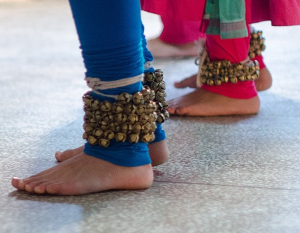About Kathak

Kathak is the classical dance form that prevails in the North of India. Kathak originated in Northern India in the temples as a form of story telling and over the years has evolved and grown into a performing art.
The word Kathak is derived from katha meaning “storytelling”. Originally, the artists known as the Kathakars told mythological stories (harikatha) in the Hindu temples of Northern India and obviously their art was deeply rooted in the Hindu religion, philosophy and spirituality. This performing art that incorporates legends from ancient mythology and great Indian epics, especially from the life of Lord Krishna became quite popular in the courts of North Indian kingdoms.
Three specific forms of this genre that is three gharanas (schools), which mostly differ in emphasis given to footwork versus acting, are more famous namely, the Jaipur gharana, the Benaras gharana and the Lucknow gharana.
Kathak is based on Hindustani classical music typically performed to the accompaniment of percussion instruments such as Tabla and Pakhvaj.
Kathak at Kalaxya

At Kalaxya our goal is to preserve the dynamic and rich Indian classical traditions of Kathak dance with excellence, integrity and depth. In order for one to emerge into an amazing dancer, it is essential that knowledge of the classical dance absorbed and perfected. According to the Abhinaya Darpanam, the Sangitaratnakara and other medieval treatises, classical dance is divided into three distinct categories, that is, Nritta, Nritya and Natya:
NRITTA (pure dance & technique)
It is the demonstration of rhythm through graceful body movements. Here movements & poses of body parts do not convey any meaning but serve to add grace & variety only. Hand gestures, tatkar, dance steps, turns and concluding dance movements form the backbone of Nritta. The synchronization between rhythm and time is of utmost importance in a Nritta piece.
According to Abhinaya Darpanam, ‘Bhaavabhinayaheenam tu nrittmityabhdheeyate’, that is, that dance which does not relate to any Psychological State (bhaava) is called nritta.
NRITYA (dance with rhythm & expressions)
Nritya refers to depicting a story through facial expressions & body movements. Nritya can be described as an explanatory dance, where the lyrics of the song are conveyed using footwork, hand gestures (hasta mudras) and facial expressions (abhinaya). The dancer’s internal emotions (bhaava) should be performed in a way that should be felt by the audience.
According to Abhinaya Darpanam, ‘Rasabhaavavyanjanaadiyuktam nruttamitiryate, etannnrutyam mahaaraajsabhaayaam kalpayet sadaa’, that is, that dance which relates to Sentiment (rasa) and Psychological Staes (bhaava) is called nritya.
NATYA (drama)
Natya means dramatic representation or drama with speech, music and dancing. Natya is achieving a story through speech, music, Nritta and Nritya. Natya is an excellent element of classical dancing through which a dancer can express every known human emotion and feeling. Natya is the dramatic element of classical Indian dance. The dancers take on the roles of characters and perform a dramatic story through music and dance. It is combined manifestation of Bhava, Rasa & abhinaya.
According to Abhinaya Darpanam, ‘Naatyam tannaatakam chava pujyam purvakathaayutam’, that is Natya or Nataka which has some traditional story for its theme is an adorable (art).
Our goal at Kalaxya is to ensure each student learns, practices and masters each of the categories of this beautiful dance form. At Kalaxya, students are given individual attention and guidance by maintaining small class sizes. Since Kathak is a performance art, students will also be provided with opportunities to perform on stage each year.
Students will also be provided with opportunities to obtain accredited dance certification, and work towards their Visharad level diploma at Kalakshya. The certificate exam structure is as follows:
- Prarambhik
- Praveshika – Pratham
- Praveshika – Purna
- Madhyama – Pratham
- Madhyama – Purna
- Visharad – Pratham
- Visharad – Purna
